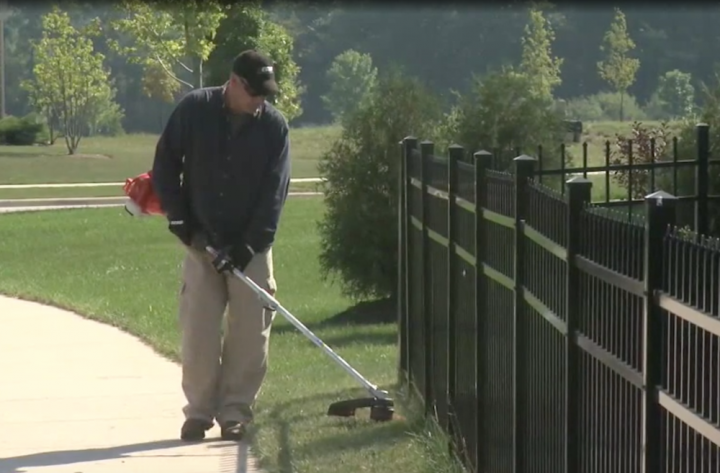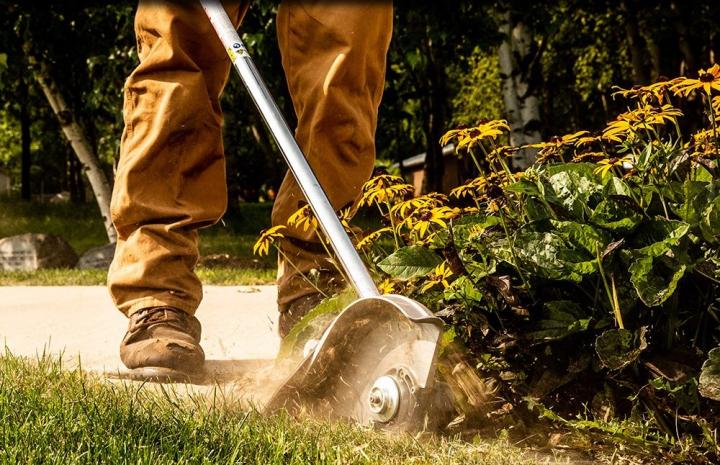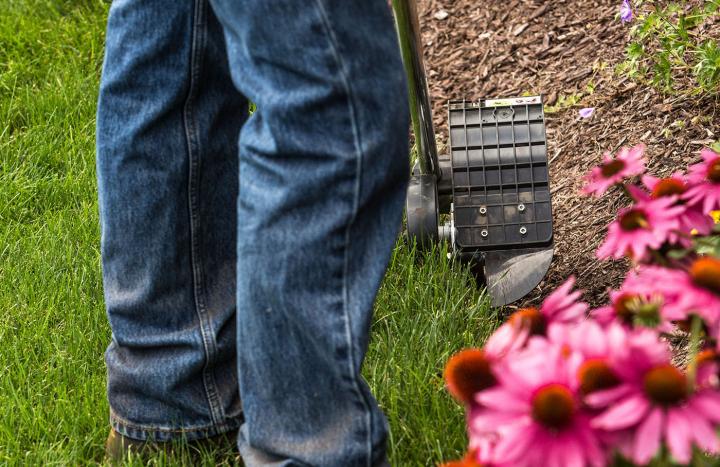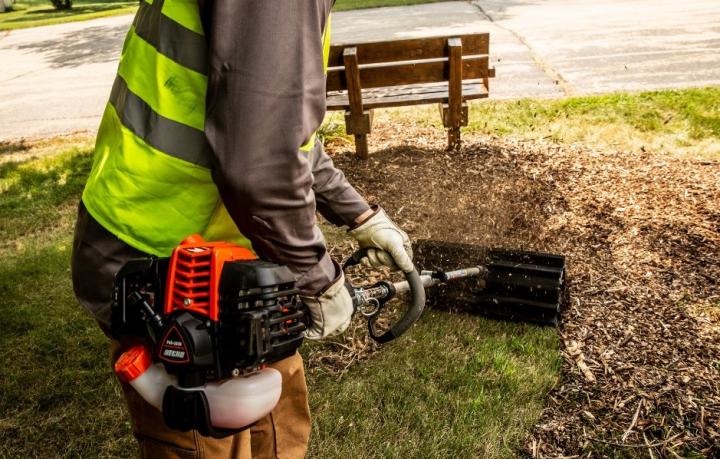How do you deal with tall grasses and weeds around the mailbox, front steps, fences, and flower beds to care for your property? How do you keep brush in your backyard at bay? How do keep grasses from creeping into your flower bed or driveway? Do it yourself—in mere seconds—and whip that landscape back in shape!
Trimming Vs. Edging: What’s the Difference?
A growing trend these days is to let your lawn go wild, but that doesn’t mean you don’t care for your property. Even a “weedy” and no-chemical lawn like the one pictured in the beautiful photo above has been trimmed, edged, and freshened up.
It may surprise you to hear that “grooming” your property is not just about looks, whether it’s a person’s hair, a dog’s nails, or your very own yard. It’s about staying healthy. First, let’s start with some basic definitions:
- Trimming: Using a string trimmer or shears to cut any grass or thin-stalked plants that the lawn mower can’t access.
- Edging: The specific act of trimming the edge of the lawn—with a tool called an edger—where a hard surface such as a path, sidewalk, or driveway meets the grass.
- Redefining: There’s a third category called “redefining.” Similar to edging, redefining is the act of correcting overgrown lawns along garden beds, “redefining” the border between them.
Not Just For Looks, But For a Healthier Yard
As with pruning, the regular trimming of your yard and lawn—if done correctly—can be good for its health. Mowing or trimming back long grass to an appropriate height encourages it to produce new shoots and become bushier, and the thicker the grass grows, the more resistant your lawn is to disease, weeds, and drought. The key thing to avoid is cutting it too short; this weakens the grass and exposes it to all the bad things that proper trimming helps prevent. A height of 2 inches is generally considered a healthy length to keep most turf grasses.
Keeping your lawn trimmed also adds value to the landscape—the clean-cut lines and boundaries are visually satisfying and help prevent the spread of weeds into other areas. Edging and redefining keep the lawn from encroaching on any hard surfaces or garden beds, which can quickly become overrun and choked by creeping grasses.
3 Tools To Make It Quick and Easy
What tool will solve which problem? Let’s take a look at a few types tool and how exactly they can help you get the job done as quickly and easily as possible without breaking your back! You may need just one tool, you may need more. It depends on what will make your yard care easier for you plus what will make the biggest difference to keeping your yard looking nice and healthy!
1. String Trimmers – if you need to access those hard-to-reach areas that the lawn mower can’t get to, such as tight corners, under fences, or along garden beds. Grasses that are left to grow wild can become unsightly and spread their seeds to unwanted areas, so it’s a good idea to trim them at the same time as when you mow. There are a few different trimmer designs out there; here are some of the key features to consider:
- Automatic- vs. Bump-feed: One of the main differences between trimmer designs is the way the string is fed through the trimmer head. With automatic-feed trimmers, the cutting string is continually kept at a certain length by sensors in the head and centrifugal force. The bump-feed design, on the other hand, requires the user to gently “bump” the bottom of the trimmer head against the ground to allow string to be fed through. While the automatic-feed may be more convenient for some, the bump-feed design allows more versatility in the length of the string, which is great for trimming in areas where a lighter touch is needed.
- Straight- vs. Curved-shaft: The traditional straight-shaft trimmer is great for heavy-duty jobs and trimming hard-to-reach areas. The curved-shaft trimmer is a bit shorter and has less reach, but is usually lighter and gives the user finer control over where they’re cutting. The angle of the curved-shaft design also makes it a lot more comfortable to operate for longer periods of time.

Photo: Trimming weeds along a fence takes mere minutes with its amazing cutting pow
2. Edgers – If you were to combine a lawn mower and a string trimmer, remove the string and turn it on its side, you would end up with a tool called an edger. Instead of string, it uses a blade that spins perpendicular to the ground, which allows the edger to easily cut along sidewalks, driveways, and walkways to remove the growth and weeds that sloppily creep over the side of your lawn onto hard surfaces.
A wheel attached to the side ensures smooth and even trimming while rolling along the edge of the lawn. Edgers are great for changing the shape of your yard, adding landscaping features, and creating a very crisp, clean, well-defined line between between your lawn and the surrounding sidewalk, driveway, or flowerbed. Like trimmers, edgers come in curved- and straight-shaft designs.

Photo: Having a clear edge not only looks good but also helps contain creeping grasses and weeds.
3. Bed Redefiners –
For the more advanced gardener, a bed definer will allow you to cut along existing garden beds or creating new ones. Flower bed and mulch bed edges erode over time and need to be redefined to maintain a fresh, welcome appearance. The old way to redefine the edge was to use a shovel but it’s tough, time-consuming work. Redefiners are similar to edgers in design, but are typically more heavy-duty and powerful, since they need to cut through thick grasses and roots.

Photo: Bed redefiners work great along vegetable or flower patches, or around landscaped plantings in the yard.
Cleaning Tools
While we’re talking tools, we have to highlight one of our favorites! As we live in New Hampshire, a lot of gravel is thrown up from snow plows onto yards and driveways. Mulch can also get thrown around the lawn. Tools like the Paddle Broom pictured below makes quick work of otherwise tedious tasks.

Photo: Use a paddle to remove stone from yards (often caused by winter snowplows) in minutes instead of raking for hours.
How to Choose the Right Tool for the Job
When deciding on what tools you will need, consider the size of your lawn and the number of obstacles you need to navigate.
- Do you have a lot of pathways, garden beds, or a large driveway bordering your lawn? A curved-shaft trimmer is perfect for a small- to medium-size yard or for trimming in delicate areas, while a powerful straight-shaft trimmer is great for large lawns with tall or dense clumps of weeds.
- If you have many pathways, a sidewalk, or a driveway at the boundary of your lawn, an edger is incredibly useful for cutting a clean line in no time.
- For maintaining or creating borders along garden beds, use a bed redefiner, which can cut through grass, weeds, and roots much faster and much more evenly than a shovel.
- If you are pressed for time or have a hard time raking, a leaf blower, paddle, or brush tool can help you to clean up quickly and neatly.
We hope that you found these tips and tools helpful in keeping your yard healthy and beautiful—without too much time! Treat yourself. After all, summer is about relaxation!
Comments